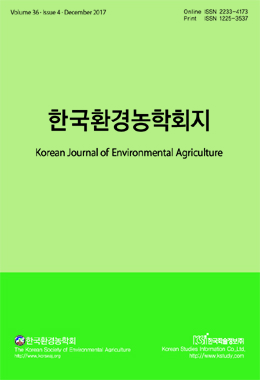본 연구는 왕우렁이의 월동실태 및 작물의 피해 실태를 파악하기 위하여 수행하였다. 왕우렁이의 도입 후 처음 월동이 확인된 지역은 2000년 해남이었다. 그 후 왕우렁이의 국내 월동 지역이 중남부지역으로 확대되었다.2017년도에 왕우렁이 개체들의 월동 지역은 전남의 강진, 고흥, 신안, 해남과 경남의 김해, 함안을 비롯한 부산과 제주, 서귀포였으며, 예외적으로 왕우렁이 월동조건이 양호하게 형성되어 있는 화성에서도 확인이 되었다. 그러나 왕우렁는 알로서 월동하지는 않았다. 왕우렁이가 저온에서 견디는 생존기간은 -5℃에서 12시간, -3℃에서 1일, -1℃에서 2일, 0℃에서 10일 및 3℃에서 30일 이상이었다. 왕우렁이들의 월동 환경조건은 10~20 cm의 물이 고여 있고, 추위에 숨을 수 있는 뻘이 잘 형성되어 있는 남향의 수로나 물 웅덩이였다. 월동 왕우렁이에 의한 피해는 벼와 미나리에서 발생하였으며 벼에서는 아직 우려할 수준은 아니었다. 다만, 미나리에서의 피해율은 4.26%로 벼에 비하여 높았고, 피해 면적도 많았다. 앞으로 왕우렁이의 국내 월동과 더불어 논 잡초방제용 왕우렁이들에 대한 지속적인 관찰과 연구가 요구된다.
BACKGROUND: The golden apple snail(GAS, Pomacea canaliculata Lamarck) is an invasive freshwater snail. It has occurred 34 years since the introduction of the GAS to the Korea. The GASs have been used recently for weed control in wet rice cultivation. The GASs’adaptability to the environment of GAS has been improved and the GASs devour the young stage of the crops as well as weeds.
METHODS AND RESULTS: We surveyed the survival area of the snails throughout the country during the winter seasons from 2000 to 2017 and crop damage due to GASs in 2017. Local maximum, minimum, and average air temperatures were monitored daily. The surveyed regions for the survival of the GASs in winters were Gangjin, Goheung, Shinan, Haenam, Gimhae, Haman, Busan, Jeju, and Seogwipo. The survival durations at low temperatures were 12 hours at -5℃, 1 day at -3℃, 2 days at -1℃, 10 days at 0℃, and over 30 days at 3℃. The eggs of GASs were not able to overwinter. The overwintering condition of the GAS needed a water depth of 10-20 cm with well formed mud. Crop damages caused by the overwintering GASs occurred in rice and water dropwort.
CONCLUSION: The overwintering GAS was first identified in Haenam, South Korea 2000 after introduction of the GAS. The overwintering area of GAS expanded to the mid-southern parts of Korea. We propose that it has not yet become a pest to rice or any other crop.


